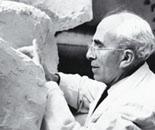
André Bloc was a highly influential cultural figure during the post-war period. Bloc first attended the École Centrale in 1920 and befriended Le Corbusier and Auguste Perret. He was a passionate advocate of integration of the arts, and architectural and urban reform. In 1930 he founded the journal “Architecture d’Aujourd’hui”, and in 1949 the influential review “Art d’Aujourd’hui”. In 1949 he embraced pure abstraction creating concrete sculptures for which he received several public commissions. In 1951 he published the “Éspace” manifesto calling for a utopian harmony through social integration of the arts, signed by many artists, designers and architects, including Le Corbusier, Alberto Magnelli, Jean Deyrolle, Serge Poliakoff, Edgard Pillet, Silvano Bozzolini, Jean Leppien and Victor Vasarely. He took a highly pluralist approach to art experimenting with a diverse range of materials. The present work is a wonderful example of his more expressionistic abstraction incorporating a remarkable amount of impasto to create an almost sculptural texture. During the 1960’s he created a series of habitable sculptures called “Cell Sculptures”, and also a radical proposal of urban reconstruction called “Parallel Paris”.
Regularly exhibiting at the avant-garde salons including the Salon des Réalités Nouvelles from 1949, and Salon de la Jeune Sculpture, Bloc established a distinguished reputation. He held numerous solo shows in Paris including at the Galerie Denise René, as well as Brussels, 1953; Milan, 1957, 1959; Amsterdam, 1958; Rome, 1958; Rio de Janeiro, 1959; Sao Paulo, 1959. Also many group shows including with Kandinsky and Poliakoff in Saarbrucken, 1954; and recently “Espace: Arte Concreta in Italia e in Francia 1948-1958”, Bologna, 1999; and “Vision Machine”, Musée des Beaux Arts, Paris, 2000; “André Bloc: Entre Art et Architecture”, Musée National d’Art Moderne, Paris, 2015.
The artist’s work can be found in many public collections.